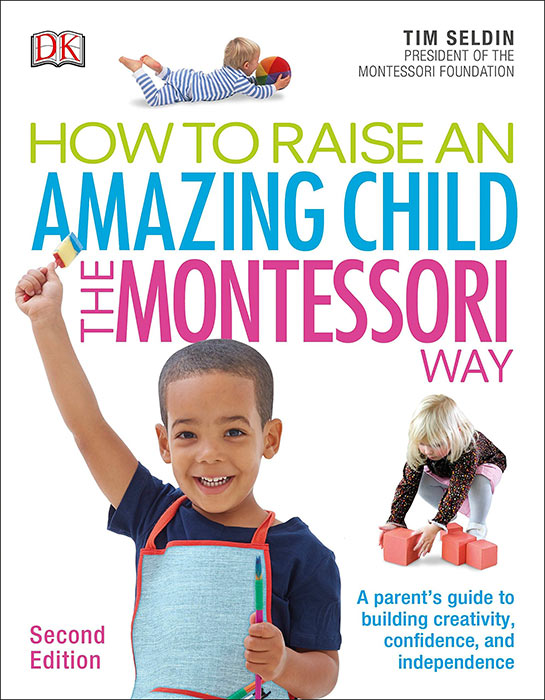7 Useful Ways to Teach the Montessori Alphabet
Wondering how to teach your child the Montessori alphabet? Discover 7 little-known but effective ways to teach letters the Montessori way.
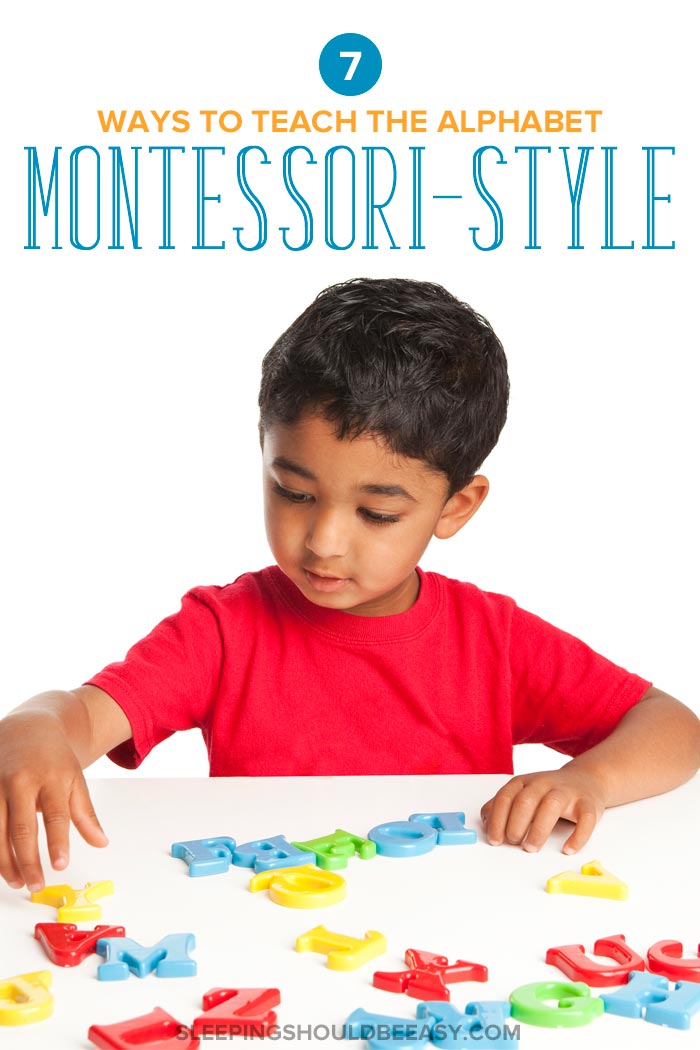
When choosing a preschool, I had heard that Montessori schools were different from traditional ones.
They encourage self-sufficiency and life skills in the curriculum (my kids called this “practical life work”). Classes aren’t divided by age so strictly. And teachers work with the individual child’s level instead of teaching the same material to all the students at the same time.
Another aspect where Montessori schools tend to differ? The way they teach the alphabet.
I recognized the difference the minute my eldest (and later, his twin brothers) was enrolled in a Montessori preschool.
I wanted to make sure that what we were doing at home stayed consistent with what he was learning at school.
So, I began to follow these seven tools for teaching the Montessori alphabet. Not only did these methods make sense, but they also followed how kids actually learn, not how we assume they should. As one parent said about the tips she learned:
“You outlined the steps so clearly, I love the guidance and reasoning. It is so logical! Thank you for providing such great information on your blog!” -Rebecca Mooney
Take a look and see if you’re teaching your child the Montessori alphabet like this:
Table of Contents
1. Call the letters by their sounds, not their names
Every Friday morning, my son’s Montessori teacher would review what he learned that week.
Except rather than saying, “We reviewed the letters ‘C’ and ‘G’,” she would say, “We reviewed the letters ‘cuh’ and ‘guh’.”
And this was her talking to me, not to my son.
Letters were identified by their sounds, not their names, to associate the visual with the sound of the letter. And in doing so, this helps kids form and read words much better.
So, the teachers would point to a letter and say its sound (“ahh” for the letter “A”) and not its name (“ay”).
Because a child who sees “C-A-T” can say “cuh-ahh-tuh” and decide that that sounds like “cat.” Compare this to another child who might see the letters and simply think, “see-ay-tee.”
Once kids are older, then they can formally learn the names of the letters. Or, more often, they’ll figure it out on their own, especially with daily reading. But tying the sounds to the letters from the start teaches them the blending of sounds.
Free printables: Want sample worksheets from my workbook, Letters and Numbers? You’ll get worksheets to help your child trace and recognize the letters of the alphabet. Grab these pdfs below—at no cost to you. You’ll also get my newsletters, which parents say they LOVE:
“Just want to say thank you, thank you, thank you. I needed that today.” -Kristy LeBlond
2. Choose the more common sound for letters with more than one
Now that you know to introduce letters by their sounds, what do you do if a letter has more than one?
For instance, the letter “C” can be said “cuh” like “cat,” as well as “sss” like “cell.” The letter “G” can either be “guh” like “gap,” or “juh” like “gem.”
In these cases, start with the more common sound. The letter “C” is usually pronounced as “cuh,” and the letter “G” has more words that sound like “guh.”
3. Start with short vowel sounds, not long
The vowels are a prime example of letters with more than one sound. Begin with the short vowel sounds first and reserve the long vowel sounds for later.
In fact, don’t expect your child to read three-letter words with vowels that have the long sound, such as “say,” just yet. Focus more on words with short vowel sounds, like “sat” or “sip.”
Thankfully, more words use short vowel sounds than long. Starting with—and sticking to—short vowel sounds for now will avoid confusion while still allowing him to read plenty of words.
4. Introduce lowercase letters first
Many of us, when we think about the ABCs, automatically imagine upper case letters. Following the Montessori alphabet method, however, means introducing lower case letters first. Why?
Words and sentences have more lower case letters, giving your child more opportunities to point out and identify them. Each time he reads a book, he’s more likely to see lower case letters than uppercase letters.
Once you see that he’s able to identify lower case letters, start introducing uppercase ones. But establish that foundation first so he can better form and recognize letters and words.
5. Don’t introduce letters in alphabetical order
Disclosure: This article contains affiliate links, which means I will earn a commission—at no extra cost to you—if you make a purchase.
It’s easy to assume that we should simply introduce letters in alphabetical order (especially when we can sing the letters this way). And down the line, kids will need to be able to organize words in alphabetical order.
But in Montessori, kids should be introduced to letters that allow them to make many words with them. Think about the first three letters of the alphabet: A, B, and C. Other than “cab,” kids really can’t form any other words with those three letters.
According How to Raise an Amazing Child the Montessori Way by Tim Seldin, here is a sample set of letters you can introduce:
- first set: c m a t
- second set: s r i p
- third set: b f o g
- fourth set: h j u l
- fifth set: d w e n
- sixth set: k q v x y z
Truthfully, every Montessori school has its own sets they begin with. Or you might even begin with the first letter of his name, assuming it’s a simple and common sound (and not something like “Ch”).
It’s not so much about following an exact order of letters, but coming up with letters that make it easier for him to identify and form words with.
6. Use movable letters and sensory items
We all learn differently, and many Montessori schools believe in nurturing all of a child’s senses to learn. Using movable letters (blocks, wooden pieces, bits of paper) as well as sensory items to write words can be a wonderful technique.
For instance, you can show your child how to write letters using sand, play dough, or paint. He can feel textures while tracing letters as an effective way to learn.
Movable letters like magnets on a refrigerator are especially useful. He’s able to form words by rearranging them, even without a pencil. This will help him to play with letters and words before he uses traditional writing tools (This was a favorite with one of my kids!).
Plus, he’ll learn that he can sometimes make new words by swapping one letter and sound for another. Imagine the impact of learning that “fin” is now “bin” just by replacing one letter.
Here are a few Montessori moveable alphabet tools that can help:
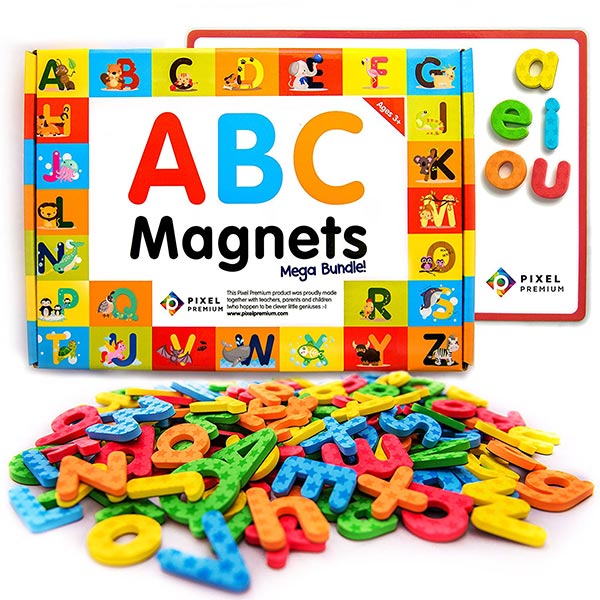

Kid Advance Montessori Small Movable Alphabet also has a different color for vowels. Letters also have more than one piece, allowing your child to spell words like “dad.”
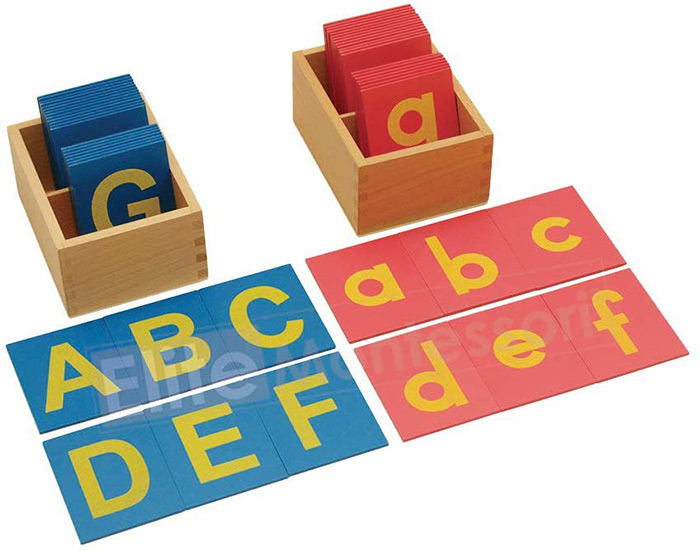
Tracing with Elite Montessori Lower and Capital Case Sandpaper Letters allows your child to use his senses to learn the shapes of the letters. The pieces can also be moved around to form words.
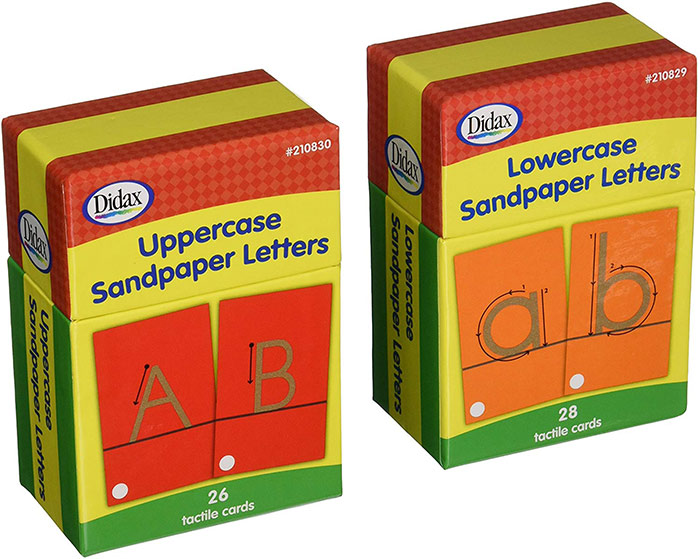
Didax Educational Resources Sandpapers Letters
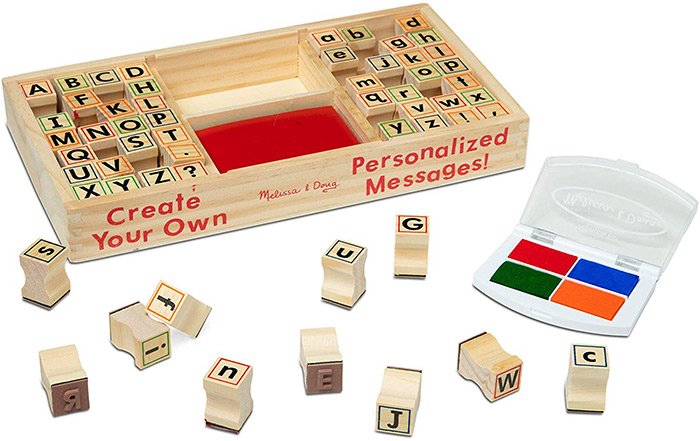
Melissa & Doug Alphabet Stamp Set makes it fun to imprint words on paper if he can’t hold a pencil yet.
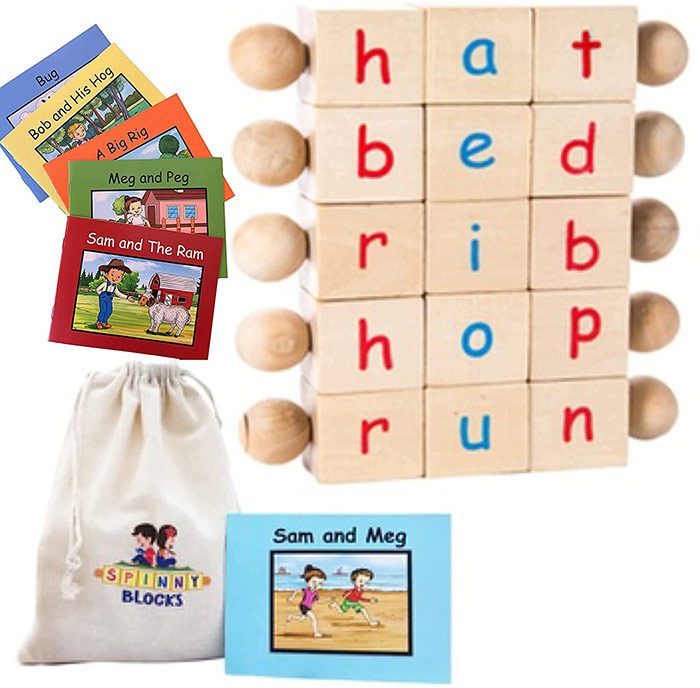
Childlearn Montessori Phonetic Letter Blocks make sounding out 3-letter words that much more intuitive.
7. Sing “letter sound” songs or rhymes
Teach alphabet sounds using music and rhymes. They’re popular among kids because they’re catchy and fun!
Find songs or rhymes that focus particularly on the sounds of the alphabet. You’ll find plenty of songs about the names of the letters, but see if you can listen to (or make up your own!) songs or rhymes about sounds.
A few ideas are:
- This Is the Sound, 102 Children’s Songs Volume 1
- Learning Our Short Vowels, 102 Children’s Songs Volume 1
- Learning Our Long Vowels, 102 Children’s Songs Volume 1
- Rhyme Time, School Days Volume 5
Conclusion
As you can see, applying the Montessori alphabet teaching method at home is simple.
Label letters by their sounds, not their names, as well as the short vowel sounds, not the long. Start with the most common sounds for those letters that have two options, and write them in lower case instead of uppercase at first.
The best order to teach letters of the alphabet are those that your child can make the most words with. Play with movable letters and sensory activities games, and sing letter sounds using songs or rhymes to reinforce what he has learned.
See if teaching the Montessori alphabet is right for your child, even if you find yourself spelling “cat” as “cuh-ah-tuh” from now on.
Don’t forget: Join my newsletter and grab these sample worksheets below—at no cost to you:


